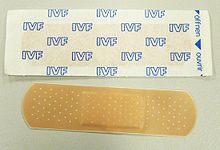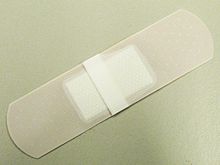Adhesive bandage: Difference between revisions
No edit summary |
+transdermal patch, organized other to fit it in |
||
| Line 2: | Line 2: | ||
[[Image:Sparadrap 3.jpg|thumb|Reverse of a adhesive bandage]] |
[[Image:Sparadrap 3.jpg|thumb|Reverse of a adhesive bandage]] |
||
[[Image:Sparadrap 4.jpg|thumb|Opened adhesive bandage, showing the non-adhesive absorbent pad and adhesive]] |
[[Image:Sparadrap 4.jpg|thumb|Opened adhesive bandage, showing the non-adhesive absorbent pad and adhesive]] |
||
An '''adhesive bandage''' (called a '''sticking plaster''', just '''plaster''', or [[Elastoplast]] (a trademark) in the [[United Kingdom]], [[New Zealand]], [[Malaysia]], [[Singapore]], and [[South Africa]]; often called [[Band-Aid]] (a trademark) generically in the [[United States]],[[Canada]], and [[Australia]]) is a small [[dressing (medical)|dressing]] used for injuries not serious enough to require a full-size [[bandage]]. |
An '''adhesive bandage''' (called a '''sticking plaster''', just '''plaster''', or [[Elastoplast]] (a trademark) in the [[United Kingdom]], [[New Zealand]], [[Malaysia]], [[Singapore]], and [[South Africa]]; often called [[Band-Aid]] (a trademark) generically in the [[United States]],[[Canada]], and [[Australia]]) is a small [[dressing (medical)|dressing]] used for injuries not serious enough to require a full-size [[bandage]]. |
||
==Function== |
|||
| ⚫ | An ''adhesive bandage'' is usually covered by woven fabric, plastic, or latex rubber which has an adhesive. Adhesive tapes used for wound care often have an absorbent pad (often medicated with |
||
The adhesive bandage protects the wound from e.g. friction damage. It protects it from dirt. Thus, the healing process of the body is less disturbed. Often they have [[antiseptic]] abilities. Some can even speed healing and minimise scarring. |
|||
==Material== |
|||
| ⚫ | Special plasters are also used by Food handlers. These are waterproof, have strong adhesive so they are less likely to fall off, and are usually bright blue in colour (so that it is obvious to the wearer if it has fallen off into some food). They are also detectable by special machines that are used in food manufacturing plants to ensure food is free from foreign objects before it is shipped to the public. |
||
| ⚫ | An ''adhesive bandage'' is usually covered by woven fabric, plastic, or latex rubber which has an adhesive. Adhesive tapes used for wound care often have an absorbent pad (often medicated with antiseptic). The plaster is applied such that the pad covers the wound (but does not stick to the wound), and the fabric or plastic sticks to the surrounding skin to hold the dressing in place and prevent dirt from entering the wound. Some newer plasters also contain woven strands of silver fibre, used to speed healing and minimise scarring. |
||
==Variations== |
|||
| ⚫ | |||
Although there are many variations for adhesive bandages with the usual protecting function, there are also types specially made for certain occasions, e.g. sports medicine, food handlers and rehabilitation. |
|||
| ⚫ | |||
| ⚫ | |||
*[[Curad]] |
*[[Curad]] |
||
*[[Elastoplast]] |
*[[Elastoplast]] |
||
| Line 18: | Line 20: | ||
*[[Micropore]] |
*[[Micropore]] |
||
*Vetrap — used in sports medicine and by [[veterinarian]]s |
*Vetrap — used in sports medicine and by [[veterinarian]]s |
||
===Food handlers=== |
|||
| ⚫ | Special plasters are also used by Food handlers. These are waterproof, have strong adhesive so they are less likely to fall off, and are usually bright blue in colour (so that it is obvious to the wearer if it has fallen off into some food). They are also detectable by special machines that are used in food manufacturing plants to ensure food is free from foreign objects before it is shipped to the public. |
||
===Rehabilitation=== |
|||
| ⚫ | |||
===Transdermal patch=== |
|||
{{Main|Transdermal patch}} |
|||
Adhesive bandages with the function to distribute medication through the skin, rather than protecting a wound, are called '''transdermal patches'''. |
|||
[[category:first aid]] |
[[category:first aid]] |
||
Revision as of 08:54, 8 July 2007



An adhesive bandage (called a sticking plaster, just plaster, or Elastoplast (a trademark) in the United Kingdom, New Zealand, Malaysia, Singapore, and South Africa; often called Band-Aid (a trademark) generically in the United States,Canada, and Australia) is a small dressing used for injuries not serious enough to require a full-size bandage.
Function
The adhesive bandage protects the wound from e.g. friction damage. It protects it from dirt. Thus, the healing process of the body is less disturbed. Often they have antiseptic abilities. Some can even speed healing and minimise scarring.
Material
An adhesive bandage is usually covered by woven fabric, plastic, or latex rubber which has an adhesive. Adhesive tapes used for wound care often have an absorbent pad (often medicated with antiseptic). The plaster is applied such that the pad covers the wound (but does not stick to the wound), and the fabric or plastic sticks to the surrounding skin to hold the dressing in place and prevent dirt from entering the wound. Some newer plasters also contain woven strands of silver fibre, used to speed healing and minimise scarring.
Variations
Although there are many variations for adhesive bandages with the usual protecting function, there are also types specially made for certain occasions, e.g. sports medicine, food handlers and rehabilitation.
Examples
- Curad
- Elastoplast
- Kinesio Tape — used by sports medicine and rehabilitation therapy
- McConnell Tape — used by sports medicine and rehabilitation therapy
- Micropore
- Vetrap — used in sports medicine and by veterinarians
Food handlers
Special plasters are also used by Food handlers. These are waterproof, have strong adhesive so they are less likely to fall off, and are usually bright blue in colour (so that it is obvious to the wearer if it has fallen off into some food). They are also detectable by special machines that are used in food manufacturing plants to ensure food is free from foreign objects before it is shipped to the public.
Rehabilitation
Other types of adhesive bandages include Kinesio and McConnell tape. These are not mediciated. Instead, these tapes are used for rehabilitation of muscles and joints. Kinesio taping can also be used to aid lymphatic flow and the treatment of Lymphedema.
Transdermal patch
Adhesive bandages with the function to distribute medication through the skin, rather than protecting a wound, are called transdermal patches.
